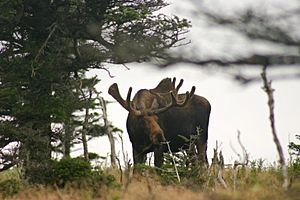Eastern moose facts for kids
Quick facts for kids Eastern moose |
|
|---|---|
 |
|
| Scientific classification |
|
| Kingdom: | Animalia |
| Phylum: | Chordata |
| Class: | Mammalia |
| Order: | Artiodactyla |
| Family: | Cervidae |
| Subfamily: | Capreolinae |
| Genus: | Alces |
| Species: | |
| Subspecies: |
A. a. americana
|
| Trinomial name | |
| Alces alces americana (Clinton, 1822)
|
|
The eastern moose (Alces alces americanus) is a type of moose found in Eastern Canada, New England, and northern New York. These large animals live in thick boreal forests and mixed deciduous forests. It is the third biggest moose in North America, smaller only than the western moose and the Alaskan moose. During mating season, male moose can be quite aggressive and might attack if they feel threatened.
Contents
Where Eastern Moose Live
The eastern moose lives across a large area in northeastern North America. This includes Canadian provinces like New Brunswick, Newfoundland and Labrador, Nova Scotia, Quebec, and Eastern Ontario. In the United States, they are found in Maine, New Hampshire, Vermont, Massachusetts, Connecticut, and northern New York.
Moose in Cape Breton Highlands National Park actually came from western moose in Alberta's Elk Island National Park.
The number of eastern moose grew a lot until the early 2000s. This happened because more trees were planted, creating more habitat for them. However, in recent years, diseases and parasites have caused their numbers to drop. These include the winter tick and brainworm.
There are about 350,000 eastern moose. About 3⁄4 of them mate every autumn and winter.
Their Home and Habitat
Eastern moose like to live in thick boreal or mixed deciduous forests. They need places with lots of food nearby. In the summer, they move closer to wetlands and water plants. They prefer cooler temperatures, usually below 15 °C (59 °F).
What Eastern Moose Eat
The eastern moose eats similar foods to other moose. They can eat up to 32 kg (71 lb) of plants from the land each day. This includes forbs (flowering plants) and young shoots from trees like willow and birch. In spring and summer, they also look for water plants such as lilies and pondweed. Like other moose, they do not have upper front teeth. Instead, they have eight sharp teeth on their lower jaw.
Size and Weight
Eastern moose are the third largest type of moose. Only the western moose and the Alaska moose are bigger. Male eastern moose usually stand about 1.7–2.0 m (5.6–6.6 ft) tall at the shoulder. They weigh around 634 kg (1,398 lb). Females are typically about 1.7 m (5.6 ft) tall at the shoulder. They weigh between 270–360 kg (600–790 lb). The antlers of male eastern moose can spread about 1.5 m (4.9 ft) wide.
How They Live and Reproduce
Most of the year, eastern moose live alone. They only meet up to mate or to fight for the right to breed. Female moose without calves are usually calm around people. Male moose make special calls to attract females or to challenge other males. When young moose are 10 to 11 months old, their mothers chase them away. This teaches them to find food and survive on their own.
Hunting Eastern Moose
Eastern moose are hunted for food and for sport during the autumn and winter months.

